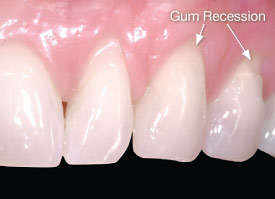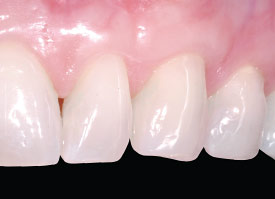Periodontal Surgery
Where Art Meets Science
(Continued)
Re-evaluation Following Initial Therapy
After three or four weeks your dentist/periodontist will evaluate the response of your periodontal tissues to the initial therapy which is being used to control the inflammation and infection induced by dental plaque. This includes oral hygiene instruction, scaling and root planing (deep cleaning) among other possible treatments. In cases where pockets are deep, 5 mm and above, the chances of successfully removing all the bacterial deposits from the root surfaces diminish, which means that they may only be removed at surgery when they can be visualized. This also applies to areas that are impossible to clean adequately because of their shapes, like “furcations,” the areas of bone loss between roots of “multi-rooted” teeth, which may only be accessed surgically.
Superficial gum tissue health in response to plaque control is critical to surgical success. If the gum tissues have not responded adequately then bacteriological testing may be indicated to ensure removal of pathogenic (disease causing) strains of bacteria by either local (applied at the site) or systemic (bodily) antibiotic treatment, or review of the diagnosis for medical conditions that may be limiting the response to initial treatment.
Surgical Therapy
 |
| Figure 1: An example of bone loss and gum recession with root exposure on three teeth with a high lip line that was a cosmetic problem when she smiled. |
 |
| Figure 2: A very nice cosmetic result with gum tissue covering the root surfaces as a result of a periodontal plastic surgical procedure. |
Periodontal surgical treatment today encompasses a variety of sophisticated plastic surgical procedures. These include techniques to repair and regenerate soft (gingival) [Figure 1 and 2] and hard (bony) tissues and replacement of missing teeth with dental implants. Procedures are usually performed by a periodontal specialist trained in these techniques and in some cases general dentists who have taken advanced training in periodontal surgery. Most procedures are performed with local anesthesia (numbing of the gum/periodontal tissues and teeth), sometimes with the additional use of oral anti-anxiety/sedation medication or intravenous conscious sedation (twilight sleep).
The objective of surgery is generally to eliminate pockets, regenerate attachment and to create more normal periodontal form, function and esthetics. The goal is to provide an environment more conducive to oral hygiene and maintenance care so that teeth can be kept for a longer period.
Risks, Benefits and Alternatives
It is important to have a discussion with your periodontist or general dentist to educate yourself regarding the risks, benefits and alternatives before undergoing treatment:
- The specific procedure you need should be discussed so you can understand what is involved. It should include what to expect after the surgery; generally mild to moderate discomfort for a day or two, usually managed by non-steroidal anti-inflammatory and analgesic medication of the Ibuprofen or Celebrex family, antibiotics and antibacterial rinses. No vigorous activity should be undertaken for the first few days to ensure that bleeding does not occur. It is also likely that the teeth will be somewhat more sensitive to cold which will disappear over time, particularly with the application of fluoride varnishes.
- What are the benefits and likely outcomes of treatment including a determination of prognosis — what results to expect and how long they will last;
- What are the alternatives to surgical treatment; this will depend upon the type and the extent of periodontal disease you have and the procedure that is recommended.
These issues will differ somewhat depending upon the type of periodontal surgical procedures. This process is called an informed consent, and you will probably be asked to acknowledge this process in writing.




